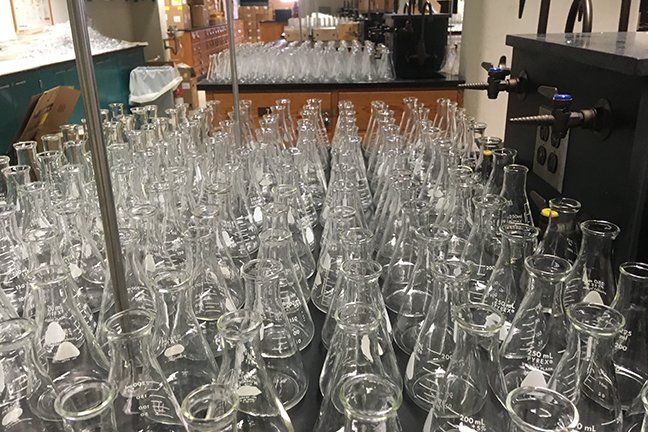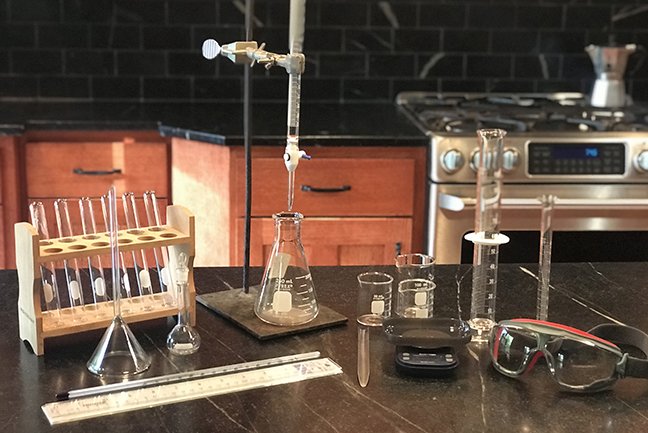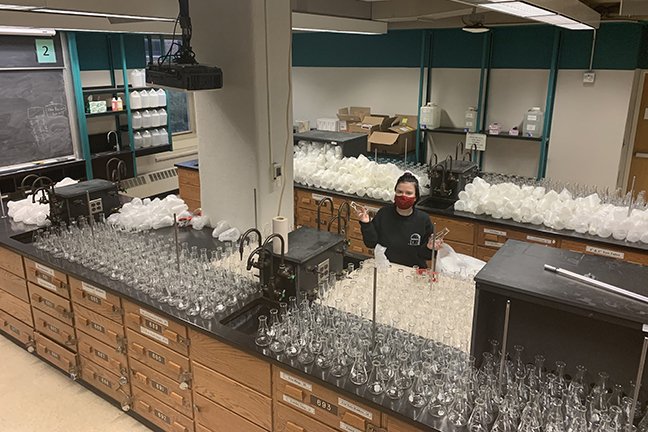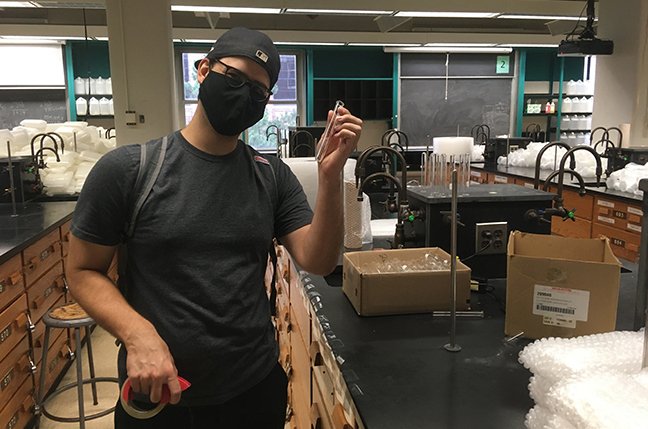Department creatively pivots instruction to meet the challenges of COVID-19 environment

Results in meaningful learning experiences for classrooms and labs
With uncertainty surrounding COVID-19 and its sometimes quick-changing impacts, the Department of Chemistry kicked off the fall semester with meaningful learning experiences for students that include online and in-person blended classroom and laboratory teaching and learning. That planning also allows for a quick pivot to all online learning, if necessary. All of this has been done with the safety of students forefront in mind and meeting COVID-19 protocols.
Professor Lee Penn, director of Undergraduate Studies, is instrumental in helping people keep up with evolving plans at the University- and college-levels and adapt to different learning modalities. Penn also obtained support from the College of Science & Engineering for the creation of two permanent video studios—one for filming laboratory experiments and one for filming lectures—plus a mobile audiovisual streaming and recording kit.
Classroom Instruction
Much of the classroom instruction is a blended combination of online teaching sessions with students and lecture recordings available later, flipped classrooms that combine online learning with focused, interactive learning activities, recorded lectures available to students on-demand, and live office hours, group discussions and presentations, and problem-solving sessions. To augment the classroom instruction, Joseph Franek, lecture demonstrations director, has put together a video library of experiments illustrating the variety of chemistry concepts taught in the courses.
Laboratory Instruction
Many dimensions of the laboratory curriculum were considered in order to still meet the learning objectives and provide laboratory experiences while operating remotely. Online laboratory learning is not ideal; however, use of problem-based pedagogies in the Department of Chemistry’s laboratory instruction has helped in the transition from in-person exploration to remote instruction by focusing on cooperative learning activities. In addition, there is a strong emphasis on green chemistry and most laboratory experiments have been updated to use small quantities of low-hazard chemicals.
Careful consideration was given to supporting learning objectives, including:
- illustrating chemical principles, techniques, and safety involved in lab projects;
- demonstrating proper use of common laboratory glassware and instruments;
- designing experimental protocols to test hypotheses;
- developing analytical thinking skills by trouble-shooting experiments;
- working effectively in groups to complete tasks;
- effectively communicating scientific information and key chemical concepts;
- demonstrating safe laboratory habits, including proper use of personal protective equipment and waste handling; and
- managing lab time effectively to obtain and properly record experimental results.
Student safety, environmental hazard levels, legal/liability issues, equipment procurement, shipping, experiment design or redesign, filming of experiments, and in-person options were other issues that needed to be worked out.
Only a few lab courses have any in-person instruction. For those lab courses that do meet on campus, plans include social distancing and careful consideration of student movement in the labs. Masks are required at all times and masks and disposable gloves are provided. The in-person portions of the laboratory instruction allow students to gain hands-on experience with lab-specific instruments, glassware, and experimentation techniques.
“I want students to have the experience of being precise and accurate in the lab, gain experience with analytical glassware, perform data analysis, and have hands-on experiences with analytical instrumentation. The data analysis is easy to do remotely, but wet chemistry and instrumentation are a bit more difficult.”—Professor Kyle Bantz who manages the department’s Analytical Chemistry program
Laboratory courses that have been modified include Organic Chemistry led by Professor Jane Wissinger, Organic Chemistry director, Life Sciences led by Professor Angela Perkins, Analytical Chemistry led by Professor Kyle Bantz, Honors Organic taught by Professor Thomas Hoye, Chemical Biology taught by Professor Erin Carlson, and Physical Chemistry taught by Professor James Johns.

General Chemistry
A herculean task encompassed preparing lab kits for the department’s general chemistry courses, which have large student enrollments of about 2,500 students per semester.
"To meet their needs, many people in the department quickly adapted processes to ensure that students could effectively learn and safely use chemistry-experiment kits."—Professor Michelle Driessen, General Chemistry director
Once the laboratory curriculum was tested at home by Professor Driessen, the General Chemistry Team of Hannah Leopold, Quin Hu and Driessen along with four experienced general chemistry lab teaching assistants, Brian Karl, Michael Hodny, Nicholas Livezey and Harrison Frisk, piloted the curriculum and experiment kits during the summer. The pilot put the department in a good place for a large-scale fall rollout.
This did not happen in a vacuum: ordering needed supplies, preparing solutions, labeling and bubble-wrapping glassware and instruments, putting together laboratory kits, and shipping or arranging for pick-up of the kits was a herculean task.
Leading the effort to obtain and order the more than 50,000 individual pieces of glassware and equipment needed were Diana Mayweather, Ph.D., senior laboratory services coordinator, and Victor Munsch, stockroom supervisor. The department’s major suppliers also provided much-needed assistance.
Developing and executing plans for preparation of the kits were Kylie Adams and Patrick Schildt, laboratory service coordinators for general chemistry, and organic and analytical chemistry, respectively. The other members of the teaching lab staff and the stockroom and receiving staff also provided invaluable assistance, including Chellina Angok, Adam Baxter, Joshua Denzer, Aminata Dotson, Phillip Ly, Isaiah Ripley, and Cristina Youngren.
With Kylie Adams leading the effort to put together the general chemistry lab kits, the laboratory staff spent the early summer months making solutions and labeling bottles. Then it was time for more than 80 volunteers, including faculty, graduate students, post-doctoral researchers and staff, to wrap glassware and assemble kits. More than 250 volunteer hours were logged. Some kits were shipped, but most were picked up in person by students living near or on campus.
“Assembling and delivering 2,500 general chemistry laboratory kits was only possible thanks to the many hours of volunteer work from our staff, students, and faculty. This was a truly remarkable example of our entire department coming together in a challenging time to provide the best experience possible for the students in our courses.”—Department Head David Blank






